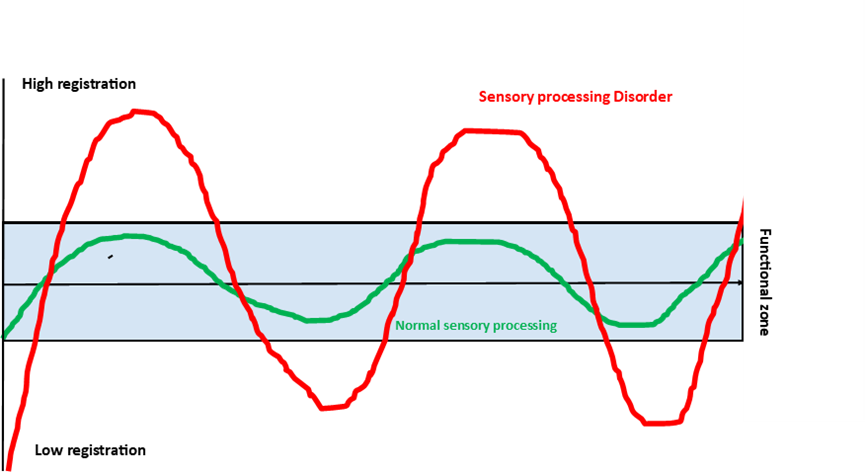Many autistics experience sensory processing difficulties sometimes connected to a hypo-reactive or hyper-reactive nervous system base line. This can be experience as sensory processing difficulties or as a comorbid sensory processing disorder, both of which effect an autistic functional capacity throughout time.
What is sensory processing?
Everyday external and internal sensory stimuli is processed by the body. External stimuli through sight, hearing, taste, touch, smell and proprioception. Internal stimuli felt through movement impacting the vestibular system. This sensory stimulus travels along the spinal cord into the nervous system and to the brain where it is processed. The brain processes these stimuli and tells the body how to react to it. In a person without sensory processing disorder or difficulties the brain will tell the body to act in a way to regulate the body and keep it calm and functioning. In a person with sensory processing difficulties the brain can not process the difficulties effectively and a person struggles to move into and stay with the calm functional zone.

Hypo-reactive and Hyper-reactive nervous system
In general terms a person’s nervous system can be described as hypo or hyper reactive, but it can be more complicated than this simplified understanding of the nervous system. In my case I fit more into the hypo-reactive nervous system, but my nervous system had an elevated baseline for as long as I can remember. This elevated baseline has resulted in me rarely displaying the expected signs of anxiety and overload such as increased heart rate, quicken breathing and sweating. The elevated baseline meant that my body was in a constant state of fight, flight or freeze and would therefore only react in extreme increases of anxiety. My hypo- reactive state is probably a combination of an elevated baseline and my sensory profile.

Understanding Sensory Processing Challenges
Sensory processing and associated difficulties can be understood by picturing where an individuals can be placed within four quadrants based on their average sensory processing data. The quadrants separate sensory processing into either high threshold or low threshold and active sensory regulation or passive sensory regulation. The best way to determine where you might fit in terms of the quadrants is to get a sensory processing assessment completed by an Occupational Therapist who understands sensory processing challenges. A good occupational therapist will get you to complete Sensory Profile Questionnaire by Winnie Dunn and Cantana Brown. They will be able to score whether you low registration, sensory avoidant, sensory seeking and/ or sensory sensitive in each of the seven senses. After they have gathered this information they can provide you with a sensory diet to help regulate your sensory processing and improve your everyday functioning.

I was quite surprised with the results of my sensory profile. I mistakenly thought I was sensory seeking because I wasn’t always sensory sensitive. The assessment revealed that I was actually low registration and sensory sensitive with some sensory avoidance. I would go along not recognising sensory input until it suddenly registered and then I would become highly reactive because my sensory sensitivity would kick in and I would be on the verge of a meltdown. I am also more likely to continue pushing through difficulties and obstacles until I end up in burn out, because of my low registration.
Unregulated Sensory Processing Difficulties
Unregulated sensory processing difficulties can cause a number of challenges to daily functioning include hyperactivity, distractibility, lack of motivation and energy, impulsivity, task avoidance, overload and meltdowns.
.png)
Comentários